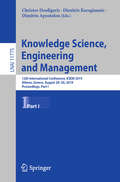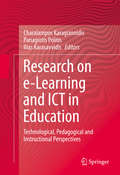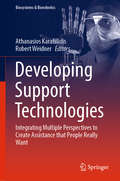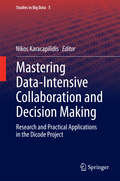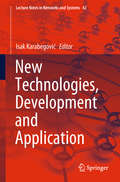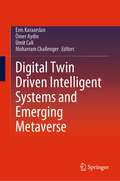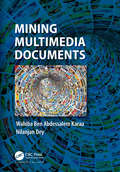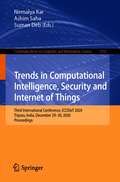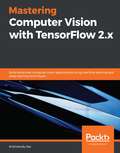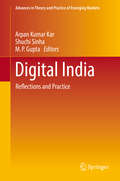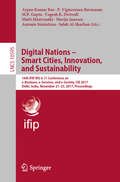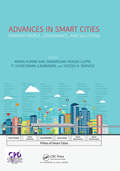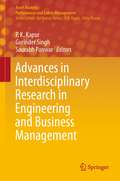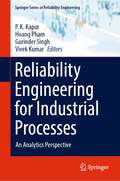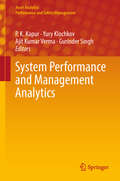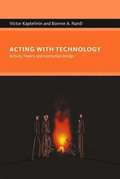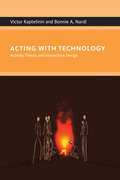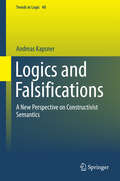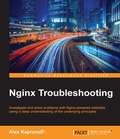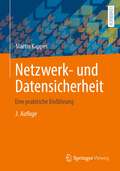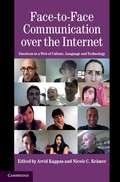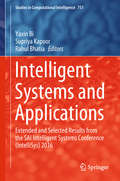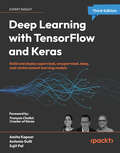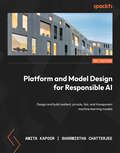- Table View
- List View
Knowledge Science, Engineering and Management: 12th International Conference, KSEM 2019, Athens, Greece, August 28–30, 2019, Proceedings, Part I (Lecture Notes in Computer Science #11775)
by Dimitris Karagiannis Christos Douligeris Dimitris ApostolouThis two-volume set of LNAI 11775 and LNAI 11776 constitutes the refereed proceedings of the 12th International Conference on Knowledge Science, Engineering and Management, KSEM 2019, held in Athens, Greece, in August 2019. The 77 revised full papers and 23 short papers presented together with 10 poster papers were carefully reviewed and selected from 240 submissions. The papers of the first volume are organized in the following topical sections: Formal Reasoning and Ontologies; Recommendation Algorithms and Systems; Social Knowledge Analysis and Management ; Data Processing and Data Mining; Image and Video Data Analysis; Deep Learning; Knowledge Graph and Knowledge Management; Machine Learning; and Knowledge Engineering Applications.The papers of the second volume are organized in the following topical sections: Probabilistic Models and Applications; Text Mining and Document Analysis; Knowledge Theories and Models; and Network Knowledge Representation and Learning.
Research on e-Learning and ICT in Education
by Charalampos Karagiannidis Panagiotis Politis Ilias KarasavvidisAn essential text for researchers and academics seeking the most comprehensive and up-to-date coverage of all aspects of e-learning and ICT in education, this book is a multidisciplinary forum covering technical, pedagogical, organizational, instructional and policy aspects of the topic. Representing the best peer-reviewed papers from the 8th Panhellenic Conference on ICT in Education, special emphasis is given to applied research relevant to educational practice and guided by the educational realities in schools, colleges, universities and informal learning organizations. The volume encompasses the current trends and issues which determine and inform the integration of ICT in educational practice, including educational software, educational games, collaborative learning, virtual learning environments, social networks, learning analytics, digital museums, as well as the evolution of e-learning.
Developing Support Technologies: Integrating Multiple Perspectives to Create Assistance that People Really Want (Biosystems & Biorobotics #23)
by Athanasios Karafillidis Robert WeidnerThis book shows the advantages of using different perspectives and scientific backgrounds for developing support technologies that are integrated into daily life. It highlights the interaction between people and technology as a key factor for achieving this integration and discusses relevant methods, concepts, technologies, and applications suitable for interdisciplinary exchange and collaboration. The relationship between humans and technology has become much more inclusive and interdependent. This generates a number of technical, ethical, social, and practical issues. By gathering contributions from scholars from heterogeneous research fields, such as biomechanics, various branches of engineering, the social sciences, information science, psychology, and philosophy, this book is intended to provide answers to the main questions arising when support technologies such as assistance systems, wearable devices, augmented reality, and/or robot-based systems are constructed, implemented, interfaced and/or evaluated across different application contexts.
Mastering Data-Intensive Collaboration and Decision Making
by Nikos KaracapilidisThis book reports on cutting-edge research carried out within the context of the EU-funded Dicode project, which aims at facilitating and augmenting collaboration and decision making in data-intensive and cognitively complex settings. Whenever appropriate, Dicode builds on prominent high-performance computing paradigms and large data processing technologies to meaningfully search, analyze, and aggregate data from diverse, extremely large and rapidly evolving sources. The Dicode approach and services are fully explained and particular emphasis is placed on deepening insights regarding the exploitation of big data, as well as on collaboration and issues relating to sense-making support. Building on current advances, the solution developed in the Dicode project brings together the reasoning capabilities of both the machine and humans. It can be viewed as an innovative "workbench" incorporating and orchestrating a set of interoperable services that reduce the data intensiveness and complexity overload at critical decision points to a manageable level, thus permitting stakeholders to be more productive and effective in their work practices.
New Technologies, Development and Application (Lecture Notes in Networks and Systems #42)
by Isak KarabegovićThe papers included in this book were presented at the International Conference “New Technologies, Development and Application,” which was held at the Academy of Sciences and Arts of Bosnia and Herzegovina in Sarajevo, Bosnia and Herzegovina on 28th–30th June 2018. The book covers a wide range of technologies and technical disciplines including complex systems such as: Robotics, Mechatronics Systems, Automation, Manufacturing, Cyber-Physical Systems, Autonomous Systems, Sensors, Networks, Control Systems, Energy Systems, Automotive Systems, Biological Systems, Vehicular Networking and Connected Vehicles, Effectiveness and Logistics Systems, Smart Grids, Nonlinear Systems, Power Systems, Social Systems, and Economic Systems.
Digital Twin Driven Intelligent Systems and Emerging Metaverse
by Enis Karaarslan Ömer Aydin Ümit Cali Moharram ChallengerThis book covers the notion of the digital twin, which has the potential to alter the way systems are governed and manufactured. It also addresses the metaverse as an emerging technology with its roots in literature, cross-platform avatars, and artificial intelligence-oriented cybersecurity issues. The untapped potential of the metaverse and digital twins as enabling technologies for the next-generation industries is emphasized in various chapters. Digital twin technology enables manufacturers to comprehend their products throughout product design better, integrate simulation, tracking, and optimization in real-time, and appropriately analyze operations. Especially for complicated products or systems, testing on a digital twin is more efficient (more accessible, quicker, less error-prone, and less expensive). The product is examined in its virtual version before it is displayed in the actual world. Additionally, the digital twin minimizes operational expenses and increases the longevity of equipment and assets. By prolonging the life of the thing, they represent and enhance its working efficiency; it may minimize operating costs and prospective capital spending. The digital twin idea is becoming a reality as it has begun to be used in several industries, including energy, manufacturing, construction, transportation, aerospace, smart cities, healthcare, cyber security, finance, and agriculture. Academic and industrial experts highlighted the most compelling use cases of digital twins and metaverses and the challenges inherent in their implementation. Readers who want to make more effective systems will find the book useful. Also, people who want to get an idea and vision of how technology will change our lives will benefit from this book.
Grundlagen der Elektrotechnik: Elektrisches und magnetisches Feld, Gleichstrom- und Wechselstromkreis, Drehstrom in der Antriebstechnik, Einführung mit Übungen
by Cihat KaraaliDas Buch hilft den Studierenden sowie den Entwicklern bei einer strukturierten Vorgehensweise zur Lösung von allgemeinen elektrotechnischen Aufgabenstellungen. Systematisch zusammengefasste Themen wie elektrisches und magnetisches Feld, Gleich- und Wechselstromkreis und Drehstrom in der Antriebstechnik sind in einem Werk mit ausführlichen Ableitungen der mathematischen Verknüpfungen sowie schematischen Darstellungen zusammengefasst. Das Buch kann auch als inhaltliche Formelsammlung angewendet werden. Auf die schematischen Darstellungen sowie ausführlichen Ableitungen wird viel Wert gelegt.
Mining Multimedia Documents
by Wahiba Ben Karaa Nilanjan DeyThe information age has led to an explosion in the amount of information available to the individual and the means by which it is accessed, stored, viewed, and transferred. In particular, the growth of the internet has led to the creation of huge repositories of multimedia documents in a diverse range of scientific and professional fields, as well as the tools to extract useful knowledge from them. <P><P>Mining Multimedia Documents is a must-read for researchers, practitioners, and students working at the intersection of data mining and multimedia applications. It investigates various techniques related to mining multimedia documents based on text, image, and video features. It provides an insight into the open research problems benefitting advanced undergraduates, graduate students, researchers, scientists and practitioners in the fields of medicine, biology, production, education, government, national security and economics.
Trends in Computational Intelligence, Security and Internet of Things: Third International Conference, ICCISIoT 2020, Tripura, India, December 29-30, 2020, Proceedings (Communications in Computer and Information Science #1358)
by Nirmalya Kar Ashim Saha Suman DebThis volume constitutes the refereed proceedings of the Third International Conference on Computational Intelligence, Security and Internet of Things, ICCISIoT 2020, held in Agartala, India, in December 2020. Due to the COVID-19 pandemic the conference was held online. The 23 full papers and 4 short papers were carefully reviewed and selected from 113 submissions. The papers are organised according to the following topics: computational intelligence, security, and internet of things.
Mastering Computer Vision with TensorFlow 2.x: Build advanced computer vision applications using machine learning and deep learning techniques
by Krishnendu KarApply neural network architectures to build state-of-the-art computer vision applications using the Python programming language Key Features Gain a fundamental understanding of advanced computer vision and neural network models in use today Cover tasks such as low-level vision, image classification, and object detection Develop deep learning models on cloud platforms and optimize them using TensorFlow Lite and the OpenVINO toolkit Book Description Computer vision allows machines to gain human-level understanding to visualize, process, and analyze images and videos. This book focuses on using TensorFlow to help you learn advanced computer vision tasks such as image acquisition, processing, and analysis. You'll start with the key principles of computer vision and deep learning to build a solid foundation, before covering neural network architectures and understanding how they work rather than using them as a black box. Next, you'll explore architectures such as VGG, ResNet, Inception, R-CNN, SSD, YOLO, and MobileNet. As you advance, you'll learn to use visual search methods using transfer learning. You'll also cover advanced computer vision concepts such as semantic segmentation, image inpainting with GAN's, object tracking, video segmentation, and action recognition. Later, the book focuses on how machine learning and deep learning concepts can be used to perform tasks such as edge detection and face recognition. You'll then discover how to develop powerful neural network models on your PC and on various cloud platforms. Finally, you'll learn to perform model optimization methods to deploy models on edge devices for real-time inference. By the end of this book, you'll have a solid understanding of computer vision and be able to confidently develop models to automate tasks. What you will learn Explore methods of feature extraction and image retrieval and visualize different layers of the neural network model Use TensorFlow for various visual search methods for real-world scenarios Build neural networks or adjust parameters to optimize the performance of models Understand TensorFlow DeepLab to perform semantic segmentation on images and DCGAN for image inpainting Evaluate your model and optimize and integrate it into your application to operate at scale Get up to speed with techniques for performing manual and automated image annotation Who this book is for This book is for computer vision professionals, image processing professionals, machine learning engineers and AI developers who have some knowledge of machine learning and deep learning and want to build expert-level computer vision applications. In addition to familiarity with TensorFlow, Python knowledge will be required to get started with this book.
Digital India: Reflections and Practice (Advances in Theory and Practice of Emerging Markets #10595)
by Arpan Kumar Kar Shuchi Sinha M. P. GuptaThis book offers a multidisciplinary resource on digital government, while specifically focusing on its role within the emerging market of India. The Government of India (GoI) is concentrating on transforming India under the Digital India initiative. In order to do so, it has emphasized three core areas: (1) Computing infrastructure as a utility to every citizen; (2) Governance and services on demand; and (3) Digital empowerment of citizens. The chapters in this book address issues surrounding these areas, highlighting concepts such as knowledge societies, urban operations and logistics, issues in managing emergent Information Communication Technologies (ICTs), and also smart analytics for urbanization. The chapters contribute to the theory, practice and policy for a “Digital India.” The book captures lessons, knowledge, experiences (about challenges, drivers, antecedents, etc.) and best practices emerging from implementation of various projects. While the book is dedicated to a “Digital India,” this book can also be valuable resource for public administrators, government officials and researchers in other emerging markets and developing countries in Asia, Africa and Latin America where similar socio-political and economic conditions exist.
Digital Nations – Smart Cities, Innovation, and Sustainability: 16th IFIP WG 6.11 Conference on e-Business, e-Services, and e-Society, I3E 2017, Delhi, India, November 21–23, 2017, Proceedings (Lecture Notes in Computer Science #10595)
by Arpan Kumar Kar P. Vigneswara Ilavarasan M. P. Gupta Yogesh K. Dwivedi Matti Mäntymäki Marijn Janssen Antonis Simintiras Salah Al-SharhanThis book constitutes the refereed conference proceedings of the 16th IFIP WG 6.11 Conference on e-Business, e-Services and e-Society, I3E 2017, held in Delhi, India, in November 2017. The 45 revised full papers presented were carefully reviewed and selected from 92 submissions. They are organized in the following topical sections: Adoption of Smart Services; Assessment of ICT Enabled Smart Initiatives; Analytics for Smart Governance; Social Media and Web 3.0 for Smartness; and Smart Solutions for the Future.
Advances in Smart Cities: Smarter People, Governance, and Solutions
by Arpan Kumar Kar M P Gupta P. Vigneswara Ilavarasan Yogesh K. DwivediThis is an edited book based on the selected submissions made to the conference titled "International Conference in Smart Cities". The project provides an innovative and new approach to holistic management of cities physical, socio-economic, environmental, transportation and political assets across all domains, typically supported by ICT and open data.
Advances in Interdisciplinary Research in Engineering and Business Management (Asset Analytics)
by P. K. Kapur Gurinder Singh Saurabh PanwarThe volume contains latest research on software reliability assessment, testing, quality management, inventory management, mathematical modeling, analysis using soft computing techniques and management analytics. It links researcher and practitioner perspectives from different branches of engineering and management, and from around the world for a bird's eye view on the topics. The interdisciplinarity of engineering and management research is widely recognized and considered to be the most appropriate and significant in the fast changing dynamics of today's times. With insights from the volume, companies looking to drive decision making are provided actionable insight on each level and for every role using key indicators, to generate mobile-enabled scorecards, time-series based analysis using charts, and dashboards. At the same time, the book provides scholars with a platform to derive maximum utility in the area by subscribing to the idea of managing business through performance and business analytics.
Reliability Engineering for Industrial Processes: An Analytics Perspective (Springer Series in Reliability Engineering)
by P. K. Kapur Hoang Pham Gurinder Singh Vivek KumarThis book explores how transformative changes driven by the new-age economy can bring about improvements in a company's engineering and manufacturing capabilities. The new-age economy is driven by advanced engineering and manufacturing practices, processes, and technologies, including the Internet of Things (IoT), Cloud Computing, Blockchain, Artificial Intelligence, Robotics, Cyber-Physical Systems (CPS), and Internet-enabled systems to automate industrial processes. Today's business dynamics are governed by uncertainties, disruptions, complexities, and ambiguities that demand quicker and more intelligent decisions. These changes could relate a renaissance in the company's engineering and manufacturing capabilities. To sustain these volatile and ever-changing business dynamics, Industry 4.0 and 5.0 have revolutionized how organizations operate and make intelligent business decisions. Moreover, the extensive role of business analytics has overcome the limitations ofclassical computing through new technologies and intelligent computing methodologies. Over the past few years, much emphasis has been given to investing in developing hardware and programming frameworks for achieving computational intelligence using fuzzy logic, evolutionary computation, neural networks, probabilistic methods, and learning theory. Within this frame of reference, the reliability, quality, and maintenance of complex industrial and manufacturing systems are essential for organizations to utilize them successfully for informed decisions. This book focuses on studies that provide new solutions for system reliability, quality, security, and maintainability using quantitative and qualitative research. It emphasizes developments and problems in systems engineering management, systems integration, software and hardware engineering, and the development process.
System Performance and Management Analytics (Asset Analytics)
by P. K. Kapur Yury Klochkov Ajit Kumar Verma Gurinder SinghThis book shares key insights into system performance and management analytics, demonstrating how the field of analytics is currently changing and how it is used to monitor companies’ efforts to drive performance.Managing business performance facilitates the effective accomplishment of strategic and operational goals, and there is a clear and direct correlation between using performance management applications and improved business and organizational results. As such, performance and management analytics can yield a range of direct and indirect benefits, boost operational efficiency and unlock employees’ latent potential, while at the same time aligning services with overarching goals.The book addresses a range of topics, including software reliability assessment, testing, quality management, system-performance management, analysis using soft-computing techniques, and management analytics. It presents a balanced, holistic approach to viewing the world from both a technical and managerial perspective by considering performance and management analytics. Accordingly, it offers a comprehensive guide to one of the most pressing issues in today’s technology-dominated world, namely, that most companies and organizations find themselves awash in a sea of data, but lack the human capital, appropriate tools and knowledge to use it to help them create a competitive edge.
Acting with Technology: Activity Theory and Interaction Design
by Victor Kaptelinin Bonnie A. NardiActivity theory holds that the human mind is the product of our interaction with people and artifacts in the context of everyday activity. Acting with Technology makes the case for activity theory as a basis for understanding our relationship with technology. Victor Kaptelinin and Bonnie Nardi describe activity theory's principles, history, relationship to other theoretical approaches, and application to the analysis and design of technologies. The book provides the first systematic entry-level introduction to the major principles of activity theory. It describes the accumulating body of work in interaction design informed by activity theory, drawing on work from an international community of scholars and designers. Kaptelinin and Nardi examine the notion of the object of activity, describe its use in an empirical study, and discuss key debates in the development of activity theory. Finally, they outline current and future issues in activity theory, providing a comparative analysis of the theory and its leading theoretical competitors within interaction design: distributed cognition, actor-network theory, and phenomenologically inspired approaches.
Acting with Technology: Activity Theory and Interaction Design (Acting with Technology)
by Victor Kaptelinin Bonnie A. NardiA systematic presentation of activity theory, its application to interaction design, and an argument for the development of activity theory as a basis for understanding how people interact with technology.Activity theory holds that the human mind is the product of our interaction with people and artifacts in the context of everyday activity. Acting with Technology makes the case for activity theory as a basis for understanding our relationship with technology. Victor Kaptelinin and Bonnie Nardi describe activity theory's principles, history, relationship to other theoretical approaches, and application to the analysis and design of technologies. The book provides the first systematic entry-level introduction to the major principles of activity theory. It describes the accumulating body of work in interaction design informed by activity theory, drawing on work from an international community of scholars and designers. Kaptelinin and Nardi examine the notion of the object of activity, describe its use in an empirical study, and discuss key debates in the development of activity theory. Finally, they outline current and future issues in activity theory, providing a comparative analysis of the theory and its leading theoretical competitors within interaction design: distributed cognition, actor-network theory, and phenomenologically inspired approaches.
Logics and Falsifications
by Andreas KapsnerThis volume examines the concept of falsification as a central notion of semantic theories and its effects on logical laws. The point of departure is the general constructivist line of argument that Michael Dummett has offered over the last decades. From there, the author examines the ways in which falsifications can enter into a constructivist semantics, displays the full spectrum of options, and discusses the logical systems most suitable to each one of them. While the idea of introducing falsifications into the semantic account is Dummett's own, the many ways in which falsificationism departs quite radically from verificationism are here spelled out in detail for the first time. The volume is divided into three large parts. The first part provides important background information about Dummett's program, intuitionism and logics with gaps and gluts. The second part is devoted to the introduction of falsifications into the constructive account and shows that there is more than one way in which one can do this. The third part details the logical effects of these various moves. In the end, the book shows that the constructive path may branch in different directions: towards intuitionistic logic, dual intuitionistic logic and several variations of Nelson logics. The author argues that, on balance, the latter are the more promising routes to take. "Kapsner's book is the first detailed investigation of how to incorporate the notion of falsification into formal logic. This is a fascinating logico-philosophical investigation, which will interest non-classical logicians of all stripes. " Graham Priest, Graduate Center, City University of New York and University of Melbourne
Nginx Troubleshooting
by Alex KapranoffInvestigate and solve problems with Nginx-powered websites using a deep understanding of the underlying principles About This Book * Solve problems with your Nginx-powered websites before your audience notices anything * Peek into the Nginx architecture and gain knowledge that will help you be valuable to you in the long run * Gain knowledge of different types of problems in a step-by-step way Who This Book Is For The book is for technical specialists who already use Nginx to serve web pages for their users. Whether you are an experienced system administrator or a new professional, this book will help you do your job in the most efficient way. What You Will Learn * Detect and investigate problems with your web servers * Create correct and professional configuration files * Get an in-depth understanding of the web server software * Interpret Nginx log files easily and with actionable insights * Make your websites respond as fast as possible * Prevent problems by setting up proper monitoring and alerts In Detail Nginx is clearly winning the race to be the dominant software to power modern websites. It is fast and open source, maintained with passion by a brilliant team. This book will help you maintain your Nginx instances in a healthy and predictable state. It will lead you through all the types of problems you might encounter as a web administrator, with a special focus on performance and migration from older software. You will learn how to write good configuration files and will get good insights into Nginx logs. It will provide you solutions to problems such as missing or broken functionality and also show you how to tackle performance issues with the Nginx server. A special chapter is devoted to the art of prevention, that is, monitoring and alerting services you may use to detect problems before they manifest themselves on a big scale. The books ends with a reference to error and warning messages Nginx could emit to help you during incident investigations. Style and approach This comprehensive tutorial on Nginx troubleshooting takes an practical approach to guiding you through common issues in Nginx server.
Netzwerk- und Datensicherheit: Eine praktische Einführung
by Martin KappesSie sind ein erfolgreicher Hacker, finden jede Sicherheitslücke, überwinden jede Firewall und sind es gewohnt, immer an Ihr Ziel zu kommen? Dann haben wir jetzt schlechte Nachrichten für Sie: Dieses Buch wird Ihnen das Leben schwer machen! Dem Autor gelingt es, solide und verständlich das Hintergrundwissen über Netzwerk- und Datensicherheit zu vermitteln, das Ihnen das Handwerk legt. Kein Problem - mir fällt immer etwas Neues ein, das nicht im Buch steht, denken Sie? Dann haben wir noch eine schlechte Nachricht: Ihre neuesten Tricks verraten wir immer aktuell auf der Homepage zum Buch.
Face-to-Face Communication over the Internet
by Arvid Kappas Nicole C. KrämerSocial platforms such as MySpace, Facebook and Twitter have rekindled the initial excitement of cyberspace. Text-based, computer-mediated communication has been enriched with face-to-face communication such as Skype, as users move from desktops to laptops with integrated cameras and related hardware. Age, gender and culture barriers seem to have crumbled and disappeared as the user base widens dramatically. Other than simple statistics relating to e-mail usage, chatrooms and blog subscriptions, we know surprisingly little about the rapid changes taking place. This book assembles leading researchers on nonverbal communication, emotion, cognition and computer science to summarize what we know about the processes relevant to face-to-face communication as it pertains to telecommunication, including video-conferencing. The authors take stock of what has been learned regarding how people communicate, in person or over distance, and set the foundations for solid research helping to understand the issues, implications and possibilities that lie ahead.
Intelligent Systems and Applications: Extended And Selected Results From The Sai Intelligent Systems Conference (intellisys) 2015 (Studies In Computational Intelligence #650)
by Supriya Kapoor Rahul Bhatia Yaxin BiThis book is a remarkable collection of chapters covering a wider range of topics, including unsupervised text mining, anomaly and Intrusion Detection, Self-reconfiguring Robotics, application of Fuzzy Logic to development aid, Design and Optimization, Context-Aware Reasoning, DNA Sequence Assembly and Multilayer Perceptron Networks. The twenty-one chapters present extended results from the SAI Intelligent Systems Conference (IntelliSys) 2015 and have been selected based on high recommendations during IntelliSys 2015 review process. This book presents innovative research and development carried out presently in fields of knowledge representation and reasoning, machine learning, and particularly in intelligent systems in a more broad sense. It provides state - of - the - art intelligent methods and techniques for solving real world problems along with a vision of the future research.
Deep Learning with TensorFlow and Keras: Build and deploy supervised, unsupervised, deep, and reinforcement learning models, 3rd Edition
by Amita Kapoor Antonio Gulli Sujit Pal Francois CholletBuild cutting edge machine and deep learning systems for the lab, production, and mobile devicesKey FeaturesUnderstand the fundamentals of deep learning and machine learning through clear explanations and extensive code samplesImplement graph neural networks, transformers using Hugging Face and TensorFlow Hub, and joint and contrastive learningLearn cutting-edge machine and deep learning techniquesBook DescriptionDeep Learning with TensorFlow and Keras teaches you neural networks and deep learning techniques using TensorFlow (TF) and Keras. You'll learn how to write deep learning applications in the most powerful, popular, and scalable machine learning stack available.TensorFlow 2.x focuses on simplicity and ease of use, with updates like eager execution, intuitive higher-level APIs based on Keras, and flexible model building on any platform. This book uses the latest TF 2.0 features and libraries to present an overview of supervised and unsupervised machine learning models and provides a comprehensive analysis of deep learning and reinforcement learning models using practical examples for the cloud, mobile, and large production environments.This book also shows you how to create neural networks with TensorFlow, runs through popular algorithms (regression, convolutional neural networks (CNNs), transformers, generative adversarial networks (GANs), recurrent neural networks (RNNs), natural language processing (NLP), and graph neural networks (GNNs)), covers working example apps, and then dives into TF in production, TF mobile, and TensorFlow with AutoML.What you will learnLearn how to use the popular GNNs with TensorFlow to carry out graph mining tasksDiscover the world of transformers, from pretraining to fine-tuning to evaluating themApply self-supervised learning to natural language processing, computer vision, and audio signal processingCombine probabilistic and deep learning models using TensorFlow ProbabilityTrain your models on the cloud and put TF to work in real environmentsBuild machine learning and deep learning systems with TensorFlow 2.x and the Keras APIWho this book is forThis hands-on machine learning book is for Python developers and data scientists who want to build machine learning and deep learning systems with TensorFlow. This book gives you the theory and practice required to use Keras, TensorFlow, and AutoML to build machine learning systems.Some machine learning knowledge would be useful. We don't assume TF knowledge.
Platform and Model Design for Responsible AI: Design and build resilient, private, fair, and transparent machine learning models
by Amita Kapoor Sharmistha ChatterjeeCraft ethical AI projects with privacy, fairness, and risk assessment features for scalable and distributed systems while maintaining explainability and sustainabilityPurchase of the print or Kindle book includes a free PDF eBookKey FeaturesLearn risk assessment for machine learning frameworks in a global landscapeDiscover patterns for next-generation AI ecosystems for successful product designMake explainable predictions for privacy and fairness-enabled ML trainingBook DescriptionAI algorithms are ubiquitous and used for tasks, from recruiting to deciding who will get a loan. With such widespread use of AI in the decision-making process, it's necessary to build an explainable, responsible, transparent, and trustworthy AI-enabled system. With Platform and Model Design for Responsible AI, you'll be able to make existing black box models transparent. You'll be able to identify and eliminate bias in your models, deal with uncertainty arising from both data and model limitations, and provide a responsible AI solution. You'll start by designing ethical models for traditional and deep learning ML models, as well as deploying them in a sustainable production setup. After that, you'll learn how to set up data pipelines, validate datasets, and set up component microservices in a secure and private way in any cloud-agnostic framework. You'll then build a fair and private ML model with proper constraints, tune the hyperparameters, and evaluate the model metrics. By the end of this book, you'll know the best practices to comply with data privacy and ethics laws, in addition to the techniques needed for data anonymization. You'll be able to develop models with explainability, store them in feature stores, and handle uncertainty in model predictions.What you will learnUnderstand the threats and risks involved in ML modelsDiscover varying levels of risk mitigation strategies and risk tiering toolsApply traditional and deep learning optimization techniques efficientlyBuild auditable and interpretable ML models and feature storesUnderstand the concept of uncertainty and explore model explainability toolsDevelop models for different clouds including AWS, Azure, and GCPExplore ML orchestration tools such as Kubeflow and Vertex AIIncorporate privacy and fairness in ML models from design to deploymentWho this book is forThis book is for experienced machine learning professionals looking to understand the risks and leakages of ML models and frameworks, and learn to develop and use reusable components to reduce effort and cost in setting up and maintaining the AI ecosystem.
